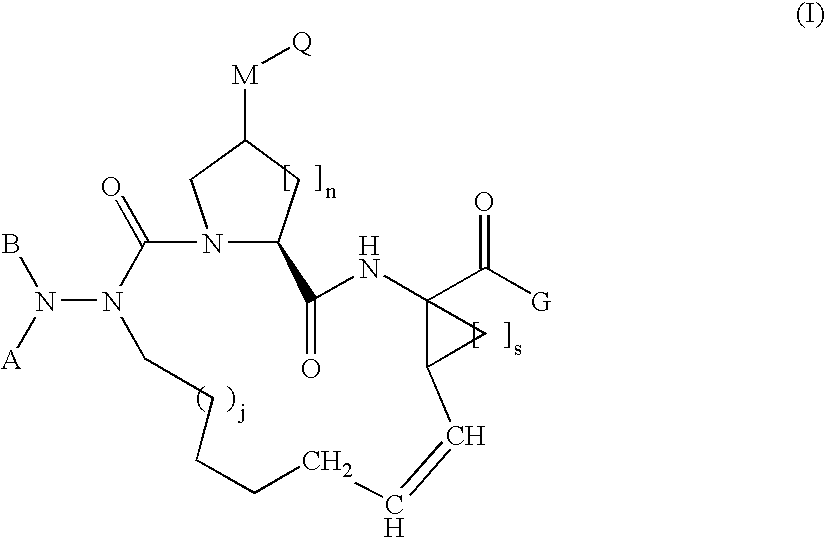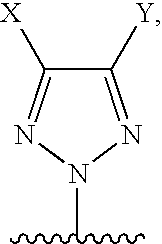Aza-peptide macrocyclic hepatitis C serine protease inhibitors
a macrocyclic hepatitis c serine protease and aza-peptide technology, applied in the field of new drugs, can solve the problems of interferon related side effects, inability to reproduce infectious culture systems and small-animal models for hcv, and increasing public health problems
- Summary
- Abstract
- Description
- Claims
- Application Information
AI Technical Summary
Problems solved by technology
Method used
Image
Examples
first embodiment
the invention is a compound represented by Formula I as described above, or a pharmaceutically acceptable salt, ester or prodrug thereof, in combination with a pharmaceutically acceptable carrier or excipient.
second embodiment
the invention is a compound represented by Formula II as described above, or a pharmaceutically acceptable salt, ester or prodrug thereof, in combination with a pharmaceutically acceptable carrier or excipient.
Representative subgenera of the invention include, but are not limited to:
A compound of formula I, wherein M is absent and Q is
wherein X and Y are each independently selected from: a) —C1-C6 alkyl containing 0, 1, 2, or 3 heteroatoms selected from O, S, or N, optionally substituted with one or more substituent selected from halogen, aryl, substituted aryl, heteroaryl, substituted heteroaryl, heterocycloalkyl, or substituted heterocycloalkyl; b) —C2-C6 alkenyl containing 0, 1, 2, or 3 heteroatoms selected from O, S, or N, optionally substituted with one or more substituent selected from halogen, aryl, substituted aryl, heteroaryl, substituted heteroaryl, heterocycloalkyl, or substituted heterocycloalkyl; c) —C2-C6 alkynyl containing 0, 1, 2, or 3 heteroatoms selected f...
example 1
Compound of Formula (1-4), Wherein j=1
A solution of 8—Bromo-oct-1-ene (26.2 mmol), Boc-hydrazine (2 eq.), and tetrabutyl-amonium iodide (˜5 mg) in 10:1 ACN / DMSO is heated to 70° C. overnight. The mixture is then cooled and the excess solvent I removed in vacuo. The concentrated reaction mixture is then purified via silica gel column chromatography (15-20% EtOAc / Hexane) to yield a compound of formula (1-3), wherein j=1, as a clear oil. Triphosgene in DCM (5 ml) is added at 0° C. to a mixture of compound of formula (1-3) and DIEA (0.8 ml) in DCM (20 ml) and stirred 1.5 hours to yield the title compound in situ to be used in subsequent steps.
PUM
| Property | Measurement | Unit |
|---|---|---|
| non-covalent | aaaaa | aaaaa |
| hydrophobic | aaaaa | aaaaa |
| pharmaceutical composition | aaaaa | aaaaa |
Abstract
Description
Claims
Application Information
 Login to View More
Login to View More - R&D
- Intellectual Property
- Life Sciences
- Materials
- Tech Scout
- Unparalleled Data Quality
- Higher Quality Content
- 60% Fewer Hallucinations
Browse by: Latest US Patents, China's latest patents, Technical Efficacy Thesaurus, Application Domain, Technology Topic, Popular Technical Reports.
© 2025 PatSnap. All rights reserved.Legal|Privacy policy|Modern Slavery Act Transparency Statement|Sitemap|About US| Contact US: help@patsnap.com



